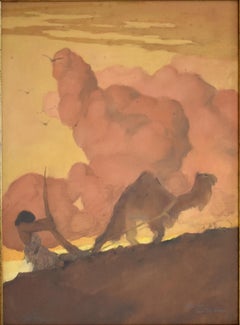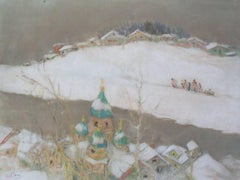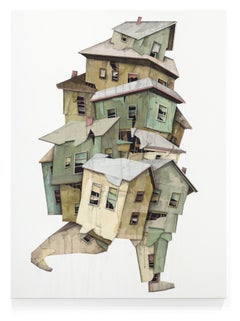Abel Pann Paintings
Russian, 1883-1963
“Over many years, Abel Pann (1883-1963) was regarded as the foremost Land Of Israel Painter. This view was shared by the Jewish community throughout the world and by the general public in pre-State Israel where reproductions of his works were hung in almost every home”. This is how Yigal Zalmone, Chief Art Curator of the Israel Museum, describes Abel Pann.
Abel Pann was born in 1883 in the town of Kreslawka in the Vitebsk region of White Russia. His father Nahum was a rabbi and head of a yeshiva, a religious academy. Pann received a Jewish elementary school education until he was twelve. He studied the fundamentals of drawing for three months with the painter Yehuda Pen of Vitebsk, who also taught Marc Chagall and Ossip Zadkine. When he was twelve he traveled between Russia and Poland, earning money as an apprentice in sign workshops. In 1898 he went south to Odessa, where he was accepted by the Academy of Fine Arts.
In 1903 Pann moved to Paris, where his work included depictions of Jewish daily life, Parisian genre paintings, as well as sketches and caricatures that were humorous and psychological criticisms regarding society. His empathy for the poor and wretched became well known.
In 1912, the director of the Bezalel School of Art and Crafts in Jerusalem asked Abel Pann to teach at the school which he accepted a year later.
During the first year of World War I, Pann was restricted to leave Europe after he returned to recover belongings to take back to Jerusalem. During the first years of the war, he concentrated on popular, nationalist posters and illustrations, including depictions of the cruelty of the German enemy.
In 1920 he returned to Jerusalem and resumed teaching at the Bezalel School, and formed the Palestine Art Publishing Company with which he used to print his albums of Bible illustrations. Abel Pann devoted much of his energy to these illustrations.
An interesting approach that Pann used in these illustrations was to depict the Biblical subjects using contemporary clothing and imagery. Using contemporary Middle Eastern characters in Oriental dress within local settings fulfilled the Zionist dream that the Jewish people were going to return to their homeland and renew their days of old.to
1
Overall Width
to
Overall Height
to
2
1
1
2
1
1
1
2
2
2
1
43
780
718
711
687
2
Artist: Abel Pann
Study for Cain was a Plowman - Pastel Russian Art
By Abel Pann
Located in London, GB
This work is hand signed in pencil by tha artist "Abel Pann" at the lower left corner.
It is also inscribed “Jerusalem” next to the signature.
The work is titled in French in pencil ...
Category
20th Century Abel Pann Paintings
Materials
Paper, Charcoal, Pastel
Russian Snowy Landscape
By Abel Pann
Located in London, GB
ABEL PANN 1883-1963
Latvia 1883-1963 Jerusalem (Russian/Latvian /Israeli)
Title: Russian Snowy Landscape
Technique: Original Signed Pastel and...
Category
Mid-20th Century Impressionist Abel Pann Paintings
Materials
Charcoal, Pastel
Related Items
Early 20th Century Pebble Beach Landscape Pastel
Located in Soquel, CA
Beautifully vivid early 20th century Pebble Beach, Carmel landscape. Signed illegibly lower right. Condition: Good. Presented in vintage frame with new mat. Image size: 7"H x 10"W.
Category
1930s American Impressionist Abel Pann Paintings
Materials
Paper, Pastel
$440 Sale Price
20% Off
H 14 in W 18.25 in D 1.25 in
"Wanderer 9" House Composition in Motion in Paint, Paper, and Charcoal
By Seth Clark
Located in Philadelphia, PA
This piece, titled "Wanderer 9" is an original artwork by Seth Clark as part of his newest solo exhibition, "Passing Through" and made of collage, charcoal, pastel, acrylic, and gra...
Category
21st Century and Contemporary Contemporary Abel Pann Paintings
Materials
Wood, Paper, Charcoal, Pastel, Acrylic, Graphite
"Wanderer 13"
By Seth Clark
Located in Philadelphia, PA
This piece, titled "Wanderer 13" is an original artwork by Seth Clark as part of his newest solo exhibition, "Passing Through", made of collage, charcoal, pastel, acrylic, and graph...
Category
21st Century and Contemporary Contemporary Abel Pann Paintings
Materials
Wood, Paper, Charcoal, Pastel, Acrylic, Graphite
"Wanderer 10" Architectural Assemblage in Collage Paper Textures and Paint Drips
By Seth Clark
Located in Philadelphia, PA
This piece, titled "Wanderer 10" is an original artwork by Seth Clark as part of his newest solo exhibition, "Passing Through" is made of collage, charcoal, pastel, acrylic, and gra...
Category
21st Century and Contemporary Contemporary Abel Pann Paintings
Materials
Wood, Paper, Charcoal, Pastel, Acrylic, Graphite
Antique American Impressionist Framed East Hampton Landscape Original Painting
Located in Buffalo, NY
Antique impressionist landscape pastel painting. Framed. In excellent original condition. Handsomely framed in a silverwood molding. Excellent condition, ready to hang and enjoy.
Category
1960s Impressionist Abel Pann Paintings
Materials
Board, Pastel
$1,475
H 40 in W 30 in D 2 in
Poppies for Miles - Impressionist Pastel Poppy Field Landscape Painting
By Dina Gardner
Located in Boston, MA
Poppies for Miles
10.0 x 8.0 x 0.1, 1.0 lbs
Pastel on archival paper
Hand signed by artist
Artist's Commentary:
"The photo reference was actually a field of daisies but I wanted ...
Category
21st Century and Contemporary Impressionist Abel Pann Paintings
Materials
Pastel
$375
H 8 in W 10 in D 0.1 in
Fluidity - Pastel Impressionist Wave Painting
By Dina Gardner
Located in Boston, MA
Fluidity
8.0 x 10.0 x 1.0, 1.0 lbs
Pastel on archival paper
Hand signed by artist
Artist's Commentary:
"This painting is a study for a larger painting I'm planning to do soon. As...
Category
21st Century and Contemporary Impressionist Abel Pann Paintings
Materials
Pastel
Carte Blanche - Pastel Impressionist Wave Painting
By Dina Gardner
Located in Boston, MA
Carte Blanche
10.0 x 8.0 x 1.0, 1.0 lbs
Pastel on archival paper
Hand signed by artist
Artist's Commentary:
"I like to paint in series and I usually also take a break, both durin...
Category
21st Century and Contemporary Impressionist Abel Pann Paintings
Materials
Pastel
Tuscany Landscape
Located in Greenville, DE
The painting is titled Tuscany Landscape and it is signed but the signature is indistinctly signed on the lower right. It is a Pastel on heavy rag p...
Category
20th Century Impressionist Abel Pann Paintings
Materials
Pastel
"Wanderer 11" Collapsing Houses in Ink Wash, Acrylic, and Collage by Seth Clark
By Seth Clark
Located in Philadelphia, PA
This piece, titled "Wanderer 11" is an original artwork by Seth Clark as part of his newest solo exhibition, "Passing Through" and is made of collage, charcoal, pastel, acrylic, and...
Category
21st Century and Contemporary Contemporary Abel Pann Paintings
Materials
Wood, Paper, Charcoal, Pastel, Acrylic, Graphite
1950s French Post Impressionist Bright Pastel Summer Garden Landscape Provence
By Josine Vignon
Located in Cirencester, Gloucestershire
Josine Vignon (French 1922-2022) ...
Category
Mid-20th Century Impressionist Abel Pann Paintings
Materials
Pastel
$957
H 25.5 in W 20 in D 1 in
Impressionist Landscape, Les Alpilles en Provence.
Located in Cotignac, FR
A French Impressionist Fauvist Color-Field pastel on fine quality 'Canson' paper landscape by G Ricard. The painting is signed bottom right.
A charming and characteristic south of ...
Category
Late 20th Century Impressionist Abel Pann Paintings
Materials
Pastel
Abel Pann paintings for sale on 1stDibs.
Find a wide variety of authentic Abel Pann paintings available for sale on 1stDibs. You can also browse by medium to find art by Abel Pann in charcoal, crayon, pastel and more. Much of the original work by this artist or collective was created during the 20th century and is mostly associated with the Impressionist style. Not every interior allows for large Abel Pann paintings, so small editions measuring 19 inches across are available. Customers who are interested in this artist might also find the work of Leonid VAICHILIA, Georges Lapchine, and Boris Mikhailovich Lavrenko. Abel Pann paintings prices can differ depending upon medium, time period and other attributes. On 1stDibs, the price for these items starts at $9,400 and tops out at $33,000, while the average work can sell for $21,200.



